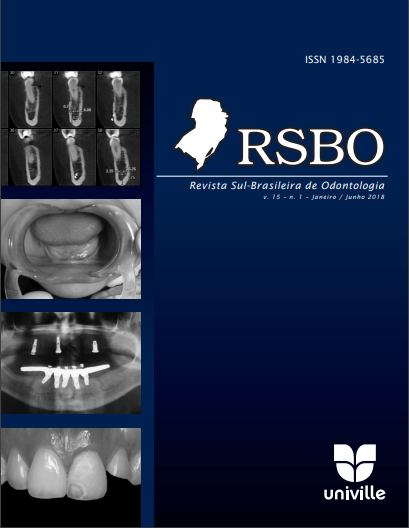Influence of the conditioning technique of a lithium disilicate vitroceramic
DOI:
https://doi.org/10.21726/rsbo.v15i1.610Palavras-chave:
ceramic; dental cements; shear strength.Resumo
Lithium disilicate reinforced glass ceramics are materials that require good adhesion to ensure clinical success. Objective: To evaluate the bond strength of resin cements to lithium-disilicateenhanced vitroceramics using different cleaning techniques of recently conditioned ceramics. Material and methods: Twelve ceramic discs (IPS Empress II) were made and inserted into PVC pipes using acrylic resin. The ceramic surface was designed and submitted to a 10% hydrofluoric acid conditioning process for 20s. Then, the specimens were divided into 3 groups (n = 16) according to the cleaning techniques of recently conditioned ceramics: 1) control - conventional technique (no cleaning after the conditioning process); 2) application of 37% phosphoric acid for 20s; 3) 90% ethyl alcohol bath in a ultrasound tub for 4 min. After cleaning, the silane agent was applied for 1 minute and silicon matrices (1 mm in diameter x 1 mm in height) were made for further application of the resin cement (Vitique, DMG), which was handled according to the manufacturer’s instructions. Four cylinders were prepared on each ceramic surface. The specimens were stored in distilled water for 48 hours and subjected to the micro-shear test in a universal testing machine. After the micro-shear test, a failure analysis of the specimens was performed. Data were submitted to ANOVA (analysis of variance for a criterion) with a significance level of 5%. Results: There was no significant difference between groups (p > 0.05). Conclusion: the cleaning technique of the recently conditioned ceramics does not interfere with the resin/cement bond strength values.

